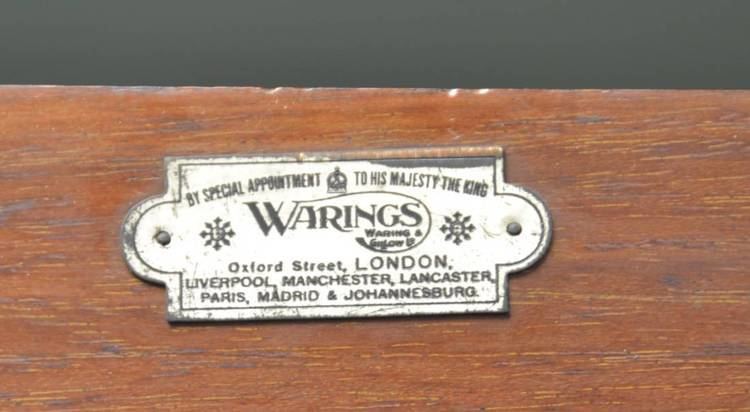Founded 1897 | ||
 | ||
Waring & Gillow is a noted firm of English furniture manufacturers formed in 1897 by the merger of Gillows of Lancaster and London and Waring of Liverpool. It was dissolved in 1938.
Contents
Gillow
The firm of Gillow's of Lancaster can be traced back to the luxury furniture and furnishings firm founded by Robert Gillow (1704–72) in about 1730. Robert Gillow served an apprenticeship as a joiner. During the 1730s he began to exploit the lucrative West Indies trade exporting mahogany furniture and importing rum and sugar. Following his death in 1772, the business was continued by his two sons, Richard (1734–1811) and Robert (1745–93). In 1764 a London branch of Gillow's was established at 176 Oxford Road, now Oxford Street, by Thomas Gillow and William Taylor. The firm rapidly established a reputation for supplying high-quality furniture to the richest families in the country.
Waring and Gillow
During the final years of the 19th century the company ran into financial difficulty and from 1897 began a loose financial arrangement with Waring of Liverpool, an arrangement legally ratified by the establishment of Waring & Gillow in 1903. Waring's of Liverpool was founded by John Waring, who arrived in the city from Belfast in 1835 and established a wholesale cabinet making business. He was succeeded by his son Samuel James Waring who rapidly expanded the business during the 1880s, furnishing hotels and public buildings throughout Europe. He also founded Waring-White Building Company which built the Liverpool Corn Exchange, Selfridge's department store and the Ritz Hotel. Samuel James's son and namesake Samuel James Waring (1860-1940) continued the family business and was elevated to the peerage as Baron Waring in 1922.
In 1932 the company was registered as Waring & Gillow(1932) Ltd and the fiche attached to the furniture claimed that their Lancaster factory was opened in 1695 [Item of furniture in the possession of this writer].
Gillow's had established a reputation for the outfitting of luxury yachts and liners, including the royal yacht Victoria and Albert, liners Lusitania, Heliopolis and Cairo, Queen Mary (1936) and Queen Elizabeth (1940) for Cunard. During the First World War the Lancaster factory was turned over to war production, making ammunition chests for the Navy and propellers for De Havilland DH9 aircraft. They also established a large tent-manufacturing facility of 8,000 workers on the now closed former exhibition site at White City (the former Machinery Hall), London.
They also made gas masks and trench covers from this site. During this time it was also at the White City site that the Workers Union first got recognition after a four-day strike mainly by women. The company also manufactured ammunition belts for use with machine guns, nosebags for horses and protective clothing for use during gas attacks.
During World War II the factory in Cambridge Grove, Hammersmith, produced parts for gliders and the Mosquito aircraft, while kit-bags, tents and camouflage nets were made by the upholstery department.
However, the business of the firm began to decline and the Lancaster workshops closed on 31 March 1962. In 1980 Waring and Gillow joined with the cabinet-making firm Maple & Co., to become Maple, Waring and Gillow, subsequently part of Allied Maples Group Ltd, which includes Allied Carpets.
